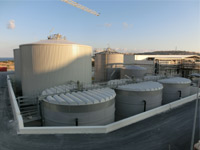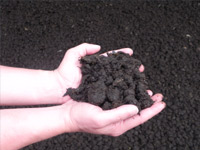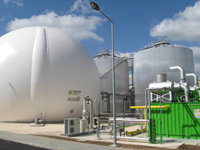The BTA® Process comprises two central steps: the BTA® Hydromechanical Pre-treatment and the subsequent wet anaerobic digestion step
The BTA® Hydromechanical Pre-treatment facilitates efficient removal of impurities as well as complete transfer of digestible organic components into an organic suspension for further anaerobic digestion. This happens within two core components, the BTA® Waste Pulper and the BTA® Grit Removal System. In the pulper the digestible organics are dissolved and defibered and brought into suspension, while the coarse impurities are removed as heavy fraction (e.g., glass, metals, stones, bones) and light fraction (e.g. plastic, textiles, woody material). In the second step, the remaining fine impurities (e.g. sand, glass splitters, egg shells) are efficiently removed in the grit removal system obtaining a clean, homogeneous and easily treatable suspension, which is then digested in a fully mixed reactor, ensuring a high biogas yield.
Further treatment of the digested substrate can be adjusted according to the respective project. Generally the digestate passes a solid-liquid separation. The dewatered digestate (ca. 30 % dry matter) is perfectly suitable for production of quality compost. In most cases most of the supernatant is utilized as process water and is retained within the cycle.
The Main advantages of the BTA® Process are:
-
a unique substrate flexibility (bio waste, commercial and food waste, MSW)
-
an efficient and selective removal of impurities
-
a high process stability and reliability
-
a better mixing of organic suspension in anaerobic digesters leading to high biogas yields
-
an intelligent process water management
-
high compost quality achievable without extensive refining steps
Where does BTA® Process find application?
Due to the high flexibility for substrates with a high range of TS-contents as well as different impurities contents, and its high efficiency in removal of these impurities for the production of a clean, easily handlable organic suspension, the BTA® Process or parts of it can be used for various, different applications:
-
Anaerobic Digestion Plants for Biowaste, Food Waste, and Commercial Waste
-
Mechanical Biological Treatment (MBT) Plants for Municipal Solid Waste
-
Co-Digestion with Sewage Sludge
-
Co-Digestion with Agricultural Residues
-
Plant Refurbishment
-
Other Applications
What will be the focus of your participation and who do you want to invite to visit your stand?
This time, in our participation case studies shall be presented, which reflect different types of anaerobic digestion plants and which prove that it is possible to obtain a quality product out of the digestate without an extensive mechanical post-treatment when having an efficient pre-treatment, which is at the same time indispensable for the reliability of the AD process and therefore the plant availability.
We would like to invite both representatives from authorities and enterprises responsible for the planning and development of the waste management infrastructure to inform themselves about the application fields and advantages of the BTA technology. At the same time, we are looking for business opportunities and potential cooperation partners in the Balkan countries, especially Bulgaria, Greece, Croatia and Serbia.
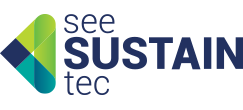
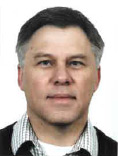 For the first time BTA International will be a part of the exhibition Save the Planet in Sofia. Please tell us more about your company and its activity in the region.
For the first time BTA International will be a part of the exhibition Save the Planet in Sofia. Please tell us more about your company and its activity in the region.